Published
on 13
Jun 2025
|
All rights reserved.
|
|
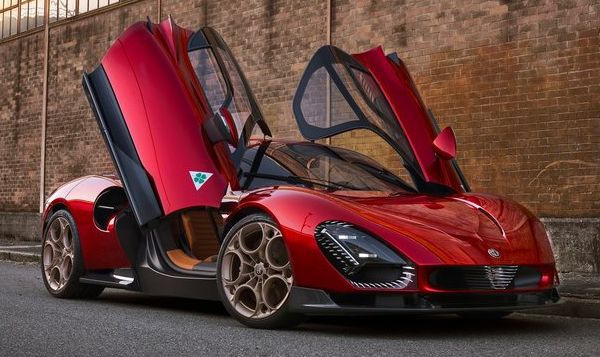
|
|
Tipo
33 reborn on Maserati bones.
|
|
The original Alfa Romeo
Tipo 33 Stradale, launched in 1967, was one of the most beautiful cars
ever built. It was also the only mid-engined supercar created by Alfa
Romeo in its entire history, something like BMW’s M1. Since then Alfa
has never got the resources and determination to build another
supercar. Fortunately, the advancement of small scale production
technologies like 3D printing, the growth of custom-built exotic car
market and relevant supply chains mean today it is possible to build a
small batch of exclusive supercars at relatively reasonable costs – as
long as you can find a few dozen buyers willing to write a cheque in
excess of 1 million euros / pounds / dollars. Alfa Romeo has managed to
do so. In 2021, it opened a small division called "Bottega" for
developing custom projects like this (think of Aston Martin's Q,
Ferrari's Special Projects program or McLaren's MSO). They held
meetings with wealthy "Alfistis" and decided the looks and
specifications of the new supercar, which is to be a modern
interpretation of 33 Stradale. Only 33 cars are to be built, each cost
1.7 million euros before local taxes but all have been sold quickly.
Assembly is contracted to Italian coachbuilder Carrozzeria Touring
Superleggera.
The styling of the new 33 successfully recaptures the spirit of the
original. Its key feature is a low and flowing waistline that makes it
incredibly sexy. Wrap-around windscreen, a full glasshouse and
butterfly doors that open part of the roof are also the trademark
features of the Tipo 33. Ditto the small winding windows, the prominent
air intakes located aft of the doors and a styling black patch located
behind the rear wheels. Even the large glass-covered headlights are
reminiscent of the original car's. My only reservation is the 3D-style
triangular grille at its nose, which is constructed from 8 pieces of
metal plates arranged like contour lines, not the chromed shield grille
we used to see on Alfa Romeos. Having said that, this has to be the
sexiest supercar currently on sale, eclipsing even Ferrari Daytona SP3
and Pininfarina Battista.
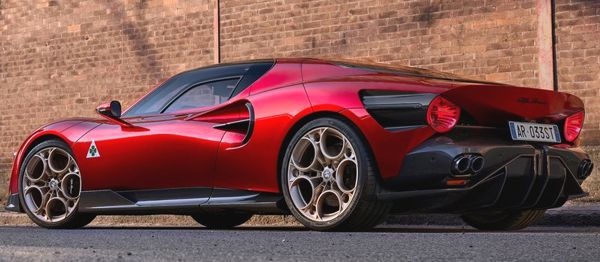
|
|
This
is probably the most beautiful car current on sale, just like Tipo 33
did nearly 60 years ago.
|
|
Understandable for such a small scale production, the 33 Stradale skips
active aero, so its Cd of 0.375 is a compromise with zero lift.
You might wonder how Alfa could afford the development costs with only
33 cars to be built. The answer is simple: it shares underpinnings with
Maserati MC20. It shares the latter's 2700mm wheelbase and is just
marginally shorter at 4.6 meters. It employs the same Dallara-built
carbon-fiber tub and aluminum subframes, although the carbon-fiber
windscreen frame and the fixed center section of roof are unique to the
Alfa, as are the butterfly doors and front and rear carbon-fiber
clamshells. It employs practically the same double-wishbone
suspensions all around, adaptive dampers and Brembo carbon ceramic
brakes controlled by wires instead of hydraulic lines. In short, the
running chassis is basically taken from Maserati with slight
modifications.
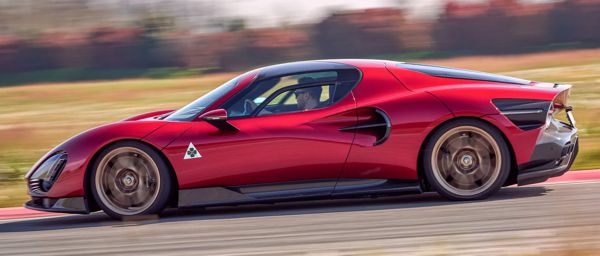
|
|
Glass
roof and big windows lend the cockpit a light and airy feel.
|
|
As for engine, Alfa Romeo claims the dry-sump 3.0-liter twin-turbo V6
evolved from the 2.9-liter wet-sump unit on Giulia QF, but it is
actually a
lightly tuned version of the Maserati "Nettuno" 3.0-liter V6, although
both engines share 90-degree V-angle. There
is Maserati's trademarked pre-chamber combustion technology and
dual-mode fuel injection, as well as an unusually high, 11.0:1
compression ratio made possible by pre-chamber. The same goes for the
Tremec 8-speed dual-clutch transaxle and active differential. The
powertrain is mounted longitudinally and drives the rear axle, of
course.
Unsurprisingly, the V6 produces almost the same output as the Maserati
MC20, i.e. 630 horsepower at 7500 rpm, accompanied with 531 pound-foot
of torque from 3000 to 5500 rpm. It is not hypercar level, obviously,
but good enough to register 207 mph at Nardo bowl and 0-60 mph in 2.9
seconds. The
entire car weighs a little more than Maserati at 1550 kg.
When the car was unveiled in 2023, Alfa planned to build an electric
version as well, said to offer at least 750 hp and even quicker
acceleration. However, that plan seems to have been shelved in the view
of declining interest in electric supercars, just like the stillborn
MC20 Folgore.

|
|
Classic
cockpit: retro seats, touchscreen-free (when flipped), buttonless
steering wheel and all mechanical switches.
|
|
Inside, the cockpit design is simple, classic and refreshing all in
one. Its retro-style seats are inspired by the original 33 Stradale’s.
Its steering wheel is completely free of buttons. Its aluminum center
console employs all mechanical switches, toggle or rotary. Further
controls can be found on the roof in airliner cockpit style. A small
infotainment touchscreen, which looks like carried over from the MC20,
can be retracted under the dashboard. The TFT instrument has 3D effect
graphics like some Peugeot cars. Driving experience should be pure, as
there are not many driving modes to choose from, only Strada (street)
and Pista (track). Stability and traction control can be switched off
in Pista mode.
On the road, the cabin certainly feels special and expensive, every bit
like a coach-built car should. You can choose between a more
traditional leather/brushed aluminum or a sportier
Alcantara/carbon-fiber trim, plus virtually countless of bespoke
materials and colors at extra costs, so no two cars are the same.
Thanks to large windows and glass roof, the cockpit is light and airy,
feeling more spacious than it is. The visibility forward and sides are
great, although rear view through that fast-angle polycarbonate rear
screen is less so. Driving position is faultless, while the thin-spoke
steering wheel is nice to hold. Switch gears give satisfying mechanical
feel missing on so many so-called “modern” cars.
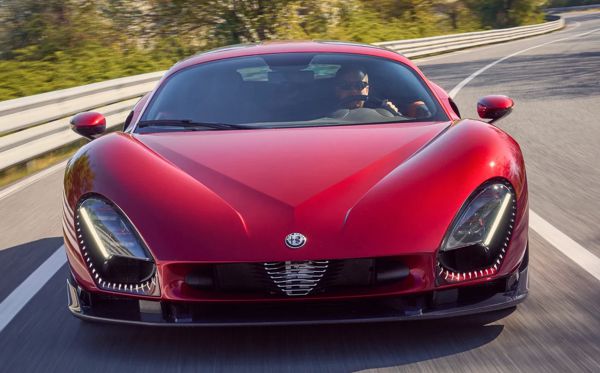
|
|
Maserati
V6 delivers strong mid-range punch with minimal lag.
|
|
To drive, the 33 Stradale feels a lot closer to its Maserati sibling
than its looks suggested. Despite different exhaust tuning, the V6
differs little in character. Maybe the noise is a bit louder and rawer
than the Maserati, but still a relatively cultured sound compared with,
say, a Ferrari or AMG V8, and its turbo whistles are just the same.
Power delivery is also the same. It lacks the linear response and top
end thrills of Ferrari V6 / V8, but the combination of minimal turbo
lag, strong mid-range torque and flexibility works satisfyingly with
the slick dual-clutch gearbox to deliver relentless acceleration. While
the car is not quite as fast as many supercars nowadays, let alone
hypercars at its price range, it is still plenty quick for road use.
There is not a lot to complain about.
Chassis dynamics are also pretty close to the Maserati. It is one of
the more refined supercars on sale. In Strada mode the suspension’s
shock absorption is fantastic. Crests and undulations fail to trouble
the rigid chassis and relatively soft suspension. Yes, the carbon-fiber
tub does sound hollow as it is constantly hit by stones being kicked up
from the surface underneath, but otherwise you can drive this supercar
everywhere without feeling tiresome. The only thing preventing it from
being used as a grand tourer is the tiny luggage space up front, but
then again, buyers of million-dollar cars have plenty of options in
their garages to do longer trips.
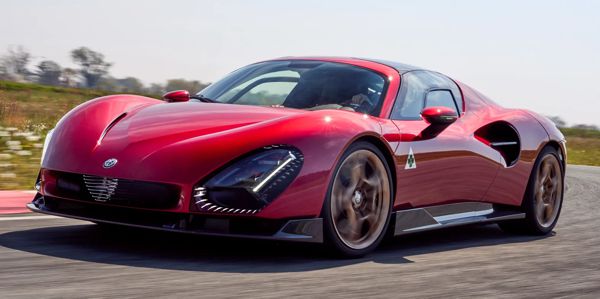
|
|
It
is not a track car. Handling is more benign and secured.
|
|
The handling of 33 Stradale can be described as competent. Its steering
is relatively slow and heavy in traditional way, and the chassis
balance is tuned to favour a little more understeer than the case of
Ferrari or McLaren, therefore it is not quite as exciting to drive on a
track. It is harder to push into slide, which might be a good thing to
collectors who want to enjoy driving this special car without risking
damaging it. Still, there are bags of grip and stopping power –
although you need to be harder on pedal. The secured handling and
supple suspension make it a good companion on B-roads, something not
many supercars can be said of.
Yes, you can have all these merits at 1/8th of the cost by purchasing a
Maserati MC20. The 33 Stradale is no quicker or better driving than its
Maserati sibling because it shares the same ingredients. However, you
might say the same to an Aston Martin Valour, Bentley Batur or any
Zagatos. Coach-built cars have always been too expensive spec. by spec.
What they offer is an exclusivity you won’t find in the mass produced
models from which they are derived. Not all coach-built cars are worth
their prices, of course, but the Alfa Romeo 33 Stradale is definitely
so because of its peerless beauty. I can’t wait for the next special
thing to be introduced by the Bottega division.
|
Verdict:     |
|